AUDI S4 CABRIOLET 2009 Owners Manual
Manufacturer: AUDI, Model Year: 2009, Model line: S4 CABRIOLET, Model: AUDI S4 CABRIOLET 2009Pages: 340, PDF Size: 77.32 MB
Page 201 of 340
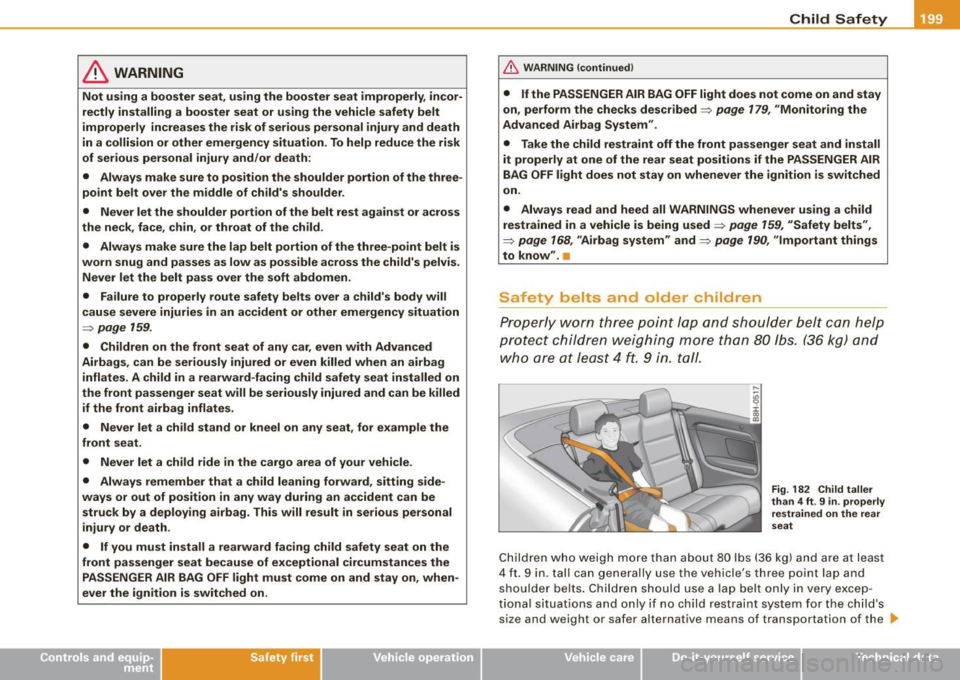
& WARNING
Not using a booster seat, using the booster seat improperly, incor
rectly installing a booster seat or using the vehicle safety belt
improperly increases the risk of serious personal injury and death
in a collision or other emergency situation. To help reduce the risk
of serious personal injury and/or death:
• Always make sure to position the shoulder portion of the three
point belt over the middle of child's shoulder .
• Never let the shoulder portion of the belt rest against or across
the neck, face, chin, or throat of the child .
• Always make sure the lap belt portion of the three-point belt is
worn snug and passes as low as possible across the child's pelvis .
Never let the belt pass over the soft abdomen.
• Failure to properly route safety belts over a child's body will
cause severe injuries in an accident or other emergency situation
=> page 159.
• Children on the front seat of any car, even with Advanced
Airbags, can be seriously injured or even killed when an airbag
inflates. A child in a rearward-facing child safety seat installed on
the front passenger seat will be seriously injured and can be killed
if the front airbag inflates.
• Never let a child stand or kneel on any seat, for example the
front seat.
• Never let a child ride in the cargo area of your vehicle.
• Always remember that a child leaning forward, sitting side
ways or out of position in any way during an accident can be
struck by a deploying airbag. This will result in serious personal
injury or death .
• If you must install a rearward facing child safety seat on the
front passenger seat because of exceptional circumstances the
PASSENGER AIR BAG OFF light must come on and stay on, when
ever the ignition is switched on .
Safety first
Child Safety
& WARNING (continued)
• If the PASSENGER AIR BAG OFF light does not come on and stay
on, perform the checks described=> page
179, "Monitoring the
Advanced Airbag System" .
• Take the child restraint off the front passenger seat and install
it properly at one of the rear seat positions if the PASSENGER AIR
BAG OFF light does not stay on whenever the ignition is switched
on .
• Always read and heed all WARNINGS whenever using a child
restrained in a vehicle is being used=> page
159 , "Safety belts",
=> page 168, "Airbag system" and=> page 190, "Important things
to know" .•
Safety belts and older children
Properly worn three point lop and shoulder belt con help
protect children weighing more than 80 lbs. (36 kg) and who ore at least 4
ft. 9 in . toll.
Fig . 182 Child taller
than 4
ft . 9 in . properly
restrained on the rear
seat
Children who weigh more than about 80 lbs (36 kg) and are at least
4 ft. 9 in . tall can generally use the vehicle's three point lap and
shoulder belts. Children should use a lap belt only in very excep
tional situations and only if no child restraint system for the child's
size and weight or safer alternative means of transportation of the •
~ehicle care irechnical data
Page 202 of 340
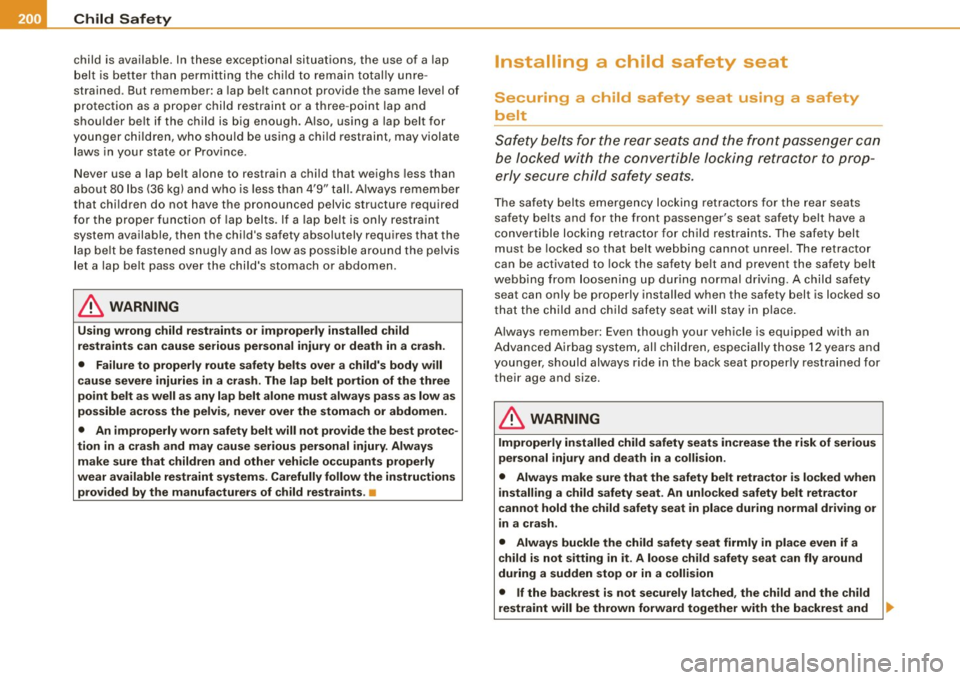
___ C_h_ i_ld _ S_ a_ f_ e_ t_ y ______________________________________________ _
child is available. In these exceptional situations, the use of a lap
belt is better than permitting the chi ld to remain totally unre
strained . But remember: a lap belt cannot provide the same level of
protec tion as a proper child restraint or a t hree -point lap and
shoulder belt if the child is big enough . Also, using a lap belt for
younger child ren, who should be using a chi ld restraint, may violate
l aws in your state or Prov ince .
Never use a lap belt alone to restrain a chi ld that weighs less than
about 80 lbs (36 kg) and who is less than 4'9" ta ll. A lways remember
that chi ldren do not have the pronounced pelvic structure required
for the proper function of lap belts. If a lap belt is only restraint
system available, then the child's safety absolutely requires that the
l ap be lt be fastened snug ly and as low as possible around the pelv is
let a lap belt pass over the chi ld's stomach or abdomen .
& WARNING
Using wrong child restraints or improperly in stalled child
restraint s can cau se serious personal inju ry or death in a cr ash.
• Fa ilure to properl y route safety belts over a child's body will
c au se severe injurie s in a crash . The lap belt portion of the three
point belt a s well a s any l ap belt alone mu st al way s pass as low as
po ssible acros s the pelvi s, never over the stom ach or abdomen.
• An improperl y worn saf ety belt will not pr ovide the best prote c
tion in a cra sh and may cau se ser iou s personal injury . Alwa ys
m ake sure that childr en and other vehicle occ upant s properl y
wear available restraint sy ste m s. Carefully follow the in struction s
pro vided by the manuf acturer s of child re strai nts. •
Installing a child safety seat
Securing a child safety seat using a safety
belt
Safe ty belts for the rear seats and the fr ont passenger can
be locked with the c onvertible locking retractor to prop
erly secure child safety seats.
The safety belts emergency locking retractors fo r the rear seats
safety be lts and for the front passenger's seat safety belt have a
conve rtible locking ret ractor for child restraints . The safety belt
must be locked so that belt webbing cannot unreel. The retractor
can be activated to lock the safety be lt and prevent the safety belt
webbing from loosening up during normal dr iving. A child safety
seat can only be properly instal led when the safety belt is locked so
that t he child and child safety seat w ill s tay i n place .
Always remember: Even though your vehicle is equipped with an
Advanced Airbag system, al l children, especially those 12 years and
younger, should always ride in the back seat p roperly restra ined for
their age and size.
& WARNING
Improperly in stalled child safety seat s increa se the risk of s erious
per sonal inju ry a nd death in a colli sion .
• Alway s m ake sure that the safe ty belt retrac tor is locked wh en
i nstalling a child safety seat . An unl ocked safety be lt retra ctor
cannot hold the ch ild safety seat in pla ce during normal driv ing or
in a cras h.
• Alway s buckle the child safety seat firml y in place even if a
c hild i s not sitting in it. A loo se child safet y seat can fl y around
during a sudden stop or in a coll ision
• If the b ackre st i s not se cu rely l atched , the ch ild and the ch ild
restraint will be thrown forward together with the bac krest and .,
Page 203 of 340
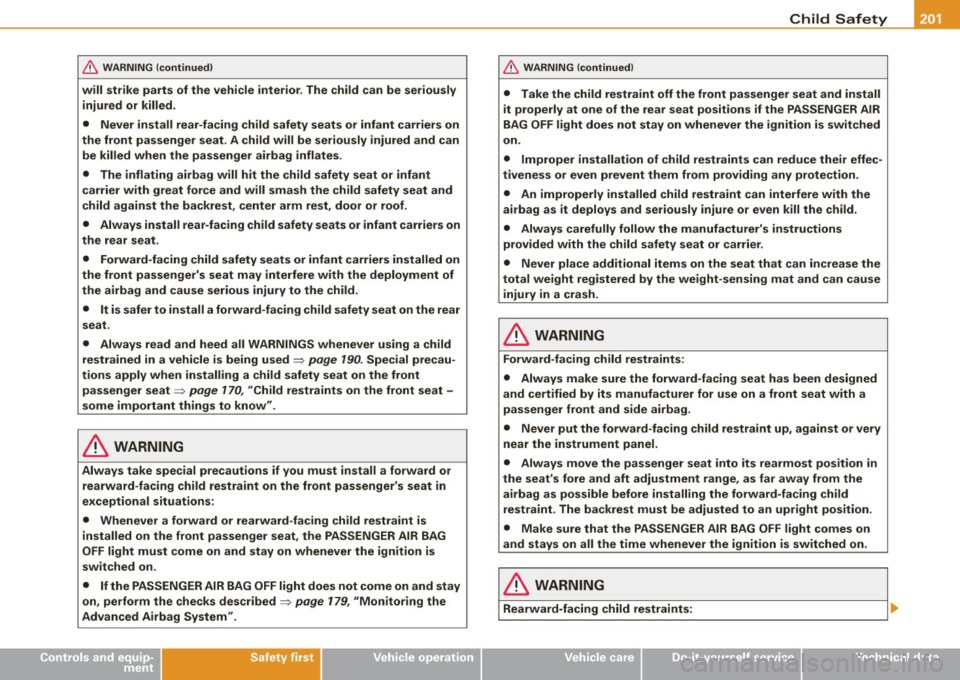
Child Safety 11!1111
-------------------------------------------------=-------
& WARNING (continued)
will strike parts of the vehicle interior. The child can be seriously
injured or killed.
• Never install rear-facing child safety seats or infant carriers on
the front passenger seat. A child will be seriously injured and can be killed when the passenger airbag inflates .
• The inflating airbag will hit the child safety seat or infant
carrier with great force and will smash the child safety seat and
child against the backrest, center arm rest, door or roof.
• Always install rear-facing child safety seats or infant carriers on
the rear seat.
• Forward-facing child safety seats or infant carriers installed on
the front passenger's seat may interfere with the deployment of
the airbag and cause serious injury to the child.
• It is safer to install a forward -facing child safety seat on the rear
seat.
• Always read and heed all WARNINGS whenever using a child
restrained in a vehicle is being used~
page 190. Special precau
tions apply when installing a child safety seat on the front passenger seat~
page 170, "Child restraints on the front seat -
some important things to know" .
& WARNING
Always take special precautions if you must install a forward or
rearward -facing child restraint on the front passenger's seat in
exceptional situations:
• Whenever a forward or rearward-facing child restraint is
installed on the front passenger seat, the PASSENGER AIR BAG
OFF light must come on and stay on whenever the ignition is
switched on.
• If the PASSENGER AIR BAG OFF light does not come on and stay
on , perform the checks described
~ page 179, "Monitoring the
Advanced Airbag System".
Controls and equip ment Safety first
Vehicle operation
& WARNING (continued)
• Take the child restraint off the front passenger seat and install
it properly at one of the rear seat positions if the PASSENGER AIR
BAG OFF light does not stay on whenever the ignition is switched
on.
• Improper installation of child restraints can reduce their effec
tiveness or even prevent them from providing any protection.
• An improperly installed child restraint can interfere with the
airbag as it deploys and seriously injure or even kill the child.
• Always carefully follow the manufacturer's instructions
provided with the child safety seat or carrier.
• Never place additional items on the seat that can increase the
total weight registered by the weight-sensing mat and can cause
injury in a crash.
& WARNING
Forward-facing child restraints:
• Always make sure the forward-facing seat has been designed
and certified by its manufacturer for use on a front seat with a
passenger front and side airbag.
• Never put the forward-facing child restraint up, against or very
near the instrument panel .
• Always move the passenger seat into its rearmost position in
the seat's fore and aft adjustment range, as far away from the
airbag as possible before installing the forward-facing child
restraint. The backrest must be adjusted to an upright position.
• Make sure that the PASSENGER AIR BAG OFF light comes on
and stays on all the time whenever the ignition is switched on.
& WARNING
Rearward -facing child restraints:
Vehicle care Do-it-yourself service Technical data
Page 204 of 340
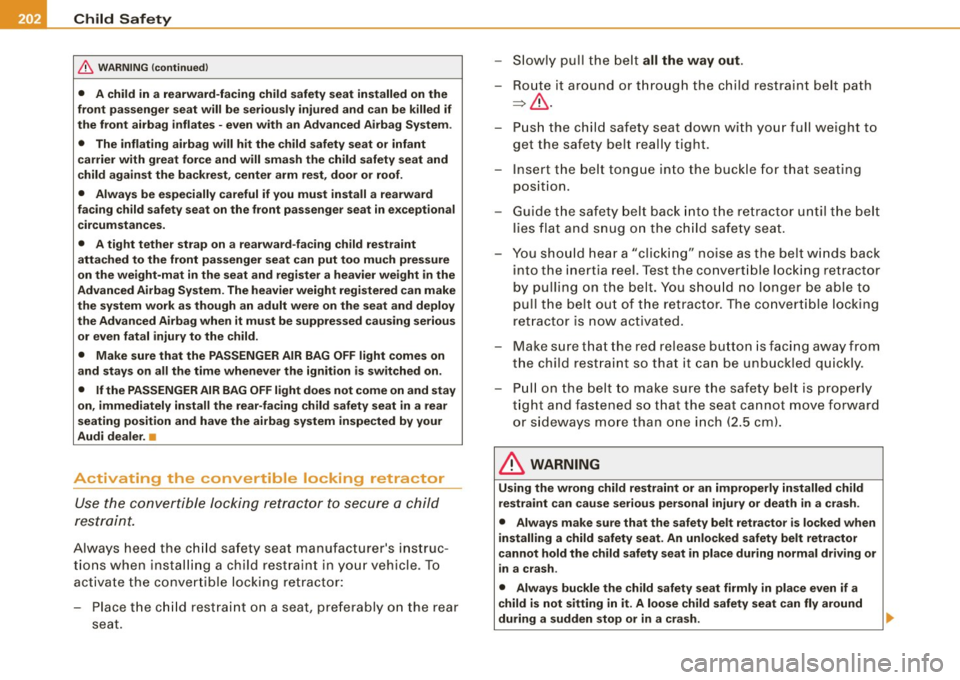
___ C_h_ i_ld _ S_ a_ f_ e_ t_ y ______________________________________________ _
& WARNING (continued)
• A child in a rearward-facing child safety seat installed on the
front passenger seat will be seriously injured and can be killed if
the front airbag inflates -even with an Advanced Airbag System.
• The inflating airbag will hit the child safety seat or infant
carrier with great force and will smash the child safety seat and
child against the backrest, center arm rest, door or roof.
• Always be especially careful if you must install a rearward
facing child safety seat on the front passenger seat in exceptional
circumstances.
• A tight tether strap on a rearward-facing child restraint
attached to the front passenger seat can put too much pressure
on the weight -mat in the seat and register a heavier weight in the
Advanced Airbag System. The heavier weight registered can make
the system work as though an adult were on the seat and deploy
the Advanced Airbag when it must be suppressed causing serious
or even fatal injury to the child.
• Make sure that the PASSENGER AIR BAG OFF light comes on
and stays on all the time whenever the ignition is switched on.
• If the PASSENGER AIR BAG OFF light does not come on and stay
on, immediately install the rear-facing child safety seat in a rear
seating position and have the airbag system inspected by your
Audi dealer. •
Activating the convertible locking retractor
Use the convertible locking retractor to secure a child
restraint.
Always heed the child safety seat manufacturer's instruc
tions when installing a child restraint in your vehicle. To
activate the convertible locking retractor:
- Place the child restraint on a seat, preferably on the rear
seat. -
Slowly pull the belt
all the way out.
- Route it around or through the child restraint belt path
=> &.
- Push the child safety seat down with your full weight to
get the safety belt really tight.
- Insert the belt tongue into the buckle for that seating position.
- Guide the safety belt back into the retractor until the belt
lies flat and snug on the child safety seat.
- You should hear a "clicking" noise as the belt winds back
into the inertia reel. Test the convertible locking retractor
by pulling on the belt. You should no longer be able to
pull the belt out of the retractor. The convertible locking
retractor is now act ivated .
- Make sure that the red release button is facing away from
the child restraint so that it can be unbuckled quickly.
- Pull on the belt to make sure the safety belt is properly
tight and fastened so that the seat cannot move forward
or sideways more than one inch (2.5 cm).
& WARNING
Using the wrong child restraint or an improperly installed child
restraint can cause serious personal injury or death in a crash.
• Always make sure that the safety belt retractor is locked when
installing a child safety seat. An unlocked safety belt retractor
cannot hold the child safety seat in place during normal driving or
in a crash.
• Always buckle the child safety seat firmly in place even if a
child is not sitting in it. A loose child safety seat can fly around
during a sudden stop or in a crash.
Page 205 of 340
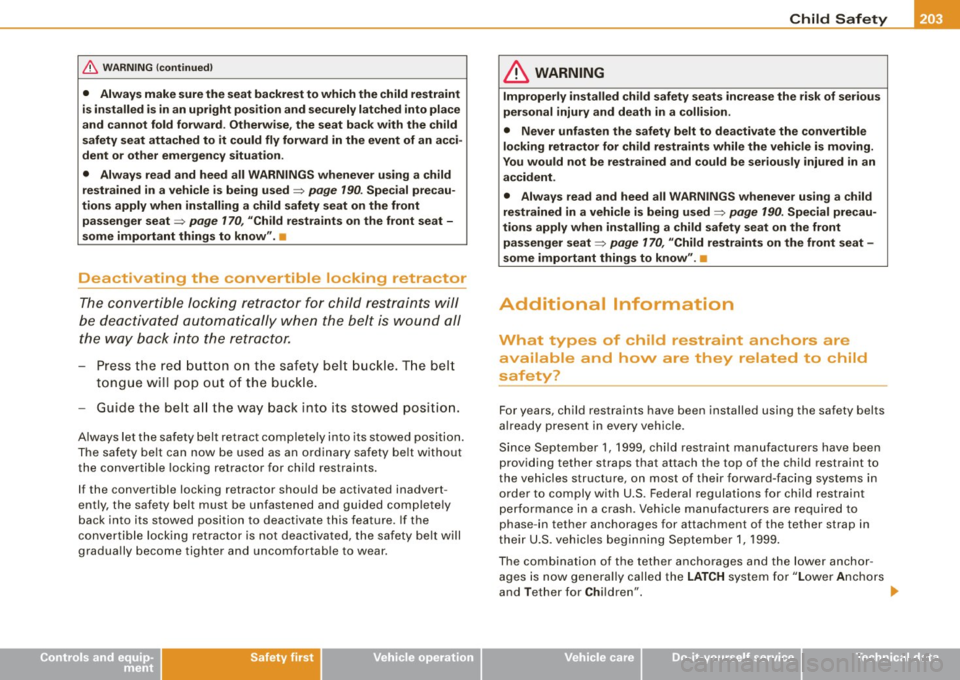
Child Safety IJ!III _________________________________ __:::...:....:...:..::.:......:__ ___ ....:.!.-__
& WARNING (continued )
• Always make sure the seat backrest to which the child restraint
is installed is in an upright position and securely latched into place
and cannot fold forward . Otherwise , the seat back with the child
safety seat attached to it could fly forward in the event of an acci
dent or other emergency situation .
• Always read and heed all WARNINGS whenever using a child
restrained in a vehicle is being used
=> page 190 . Special precau
tions apply when installing a child safety seat on the front passenger seat=>
page 170 , "Child restra ints on the front seat -
some important things to know ".•
Deactivating the convertible locking retractor
The c onver tib le l ocking retrac tor for ch ild res tra in ts will
be d ea ctivat ed automat ically wh en the belt i s wound all
th e way ba ck in to the retractor .
-Pre ss th e red bu tton o n the sa fety be lt bu ckle . Th e b elt
t o ngue will pop out of the b uck le .
- Guide the be lt all the w ay b ack in to i ts s to w ed p osition.
A lways l et t he safety belt retract complet ely into its stowed pos itio n.
T he safety belt can now be used as an ord inary safety be lt w ithout
t he conve rtibl e locking retractor for chi ld restrain ts.
I f the converti ble locking retractor should be activated inadvert
en tly, the safet y belt must be unf astened and guid ed completel y
back into its stowed pos ition to deactivat e th is feature. If the
c o nver tible loc kin g re tractor is n ot deac tiva te d , th e safe ty be lt wi ll
g radua lly becom e tighter and uncomfortab le to w ear .
Controls and equip
ment Safety first Vehicle operation
& WARNING
Improperly installed
child safety seats in crease the risk of serious
personal injury and death in a collision.
• Never unfasten the safety belt to deactivate the convertible
locking retractor for child restraints while the vehicle is moving .
You would not be restrained and could be seriously injured in an
accident.
• Always read and heed all WARNINGS whenever using a child
restrained in a vehicle is being used=>
page 190. Special precau
tions apply when installing a child safety seat on the front
passenger seat=>
page 170 , "Child restraints on the front seat -
some important things to know ".•
Additional Information
What types of child restraint anchors are
available and how are they related to child
safety?
F or years, chil d restraints have been installed using the safety belts
a lre ady pre s en t in ev ery ve hicle .
Sinc e Septem ber 1, 1999, c hild restraint manufactur ers have b een
providing tether straps that attach the top of the chi ld rest raint to
th e veh icles structure, on most of t heir forward -facin g syst ems in
order to com ply with U.S. Federal regulations for child restraint
per formanc e in a cras h. V ehi cle m anu fac tur ers a re r equi red to
phase -i n tether ancho rages for attach ment of the tether st rap in
their U.S. veh icles beginni ng Septem ber 1, 1999.
The combi nation of the t ether anc horag es and t he lower anchor
age s is now gene ra lly calle d th e
LATCH system f or "Lo w er An chors
and Tether for Children ". ..,
Vehicle care Do-it-yourself service Technical data
Page 206 of 340
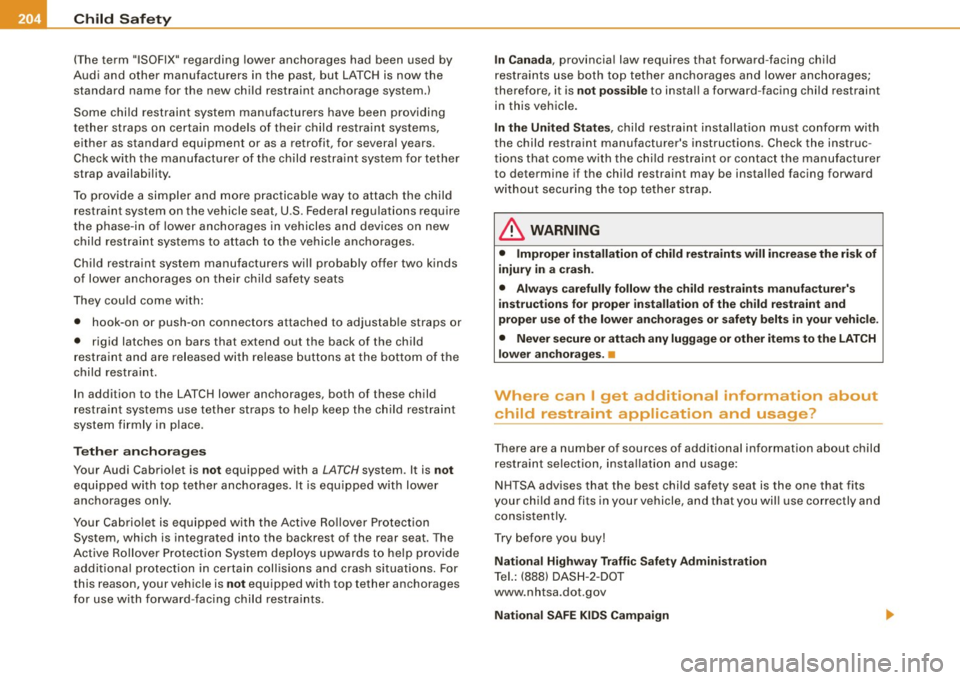
___ C_h_ i_ld _ S_ a_ f_ e_ t_ y ______________________________________________ _
(T he term "ISOFIX" regarding lower anchorages had been used by
Audi and other man ufacturers in the past, but LATC H is now the
standard name for the new child restraint anchorage system.)
Some chi ld restraint system manufacturers have been providing
t e th er straps on certain mode ls of their child restraint systems,
either as standard equipment or as a retrofit, for several years .
Check w ith the manu facturer of the ch ild restra int syste m for tether
strap availabili ty .
T o provide a simpler and more p racticab le way to a ttach the child
restraint system on the vehicle seat, U .S . Federal regulations require
the phase -in of lower anchorages in vehicles and devices on new
child restraint systems to attach to the vehicle anchora ges.
Child restraint system manufacturers will probab ly offer two kinds
o f lower a nchorages on their child safety seats
T hey could come with:
• hook-on o r push-on connectors attached to adjus tab le straps or
• rigid latches on bars that extend out the back of the ch ild
r est raint and are re leased w ith release but tons a t the bottom of the
child restra int.
I n addition to the LATCH lower anchorages, both of th ese child
r estra int syst ems use tether straps to help keep the c hild restrai nt
system firmly in p lace .
Tether an chorages
Your Audi Cabriolet is not equipped with a
LATCH system. It is not
equ ipp ed with top tether anchorages . It is equ ipped wit h lo wer
anchorages on ly.
Your Ca briolet is equipped with the Ac tive Rollover Protect ion
System, which is integrated into the backrest of the rear seat. The
Active Rollove r Protection System deploys upwards to help provide
additional protection in certain coll isions a nd cras h situations. For
this reason, your vehicle is not equipped with top tether anchorages
f or use with forward -facing child restra ints . In Canada
, provincia l law requires that forward -facing child
res tra ints use both t op tethe r anc horages and l owe r an ch orages;
therefore, it is not possible to insta ll a forward -facing chi ld restraint
i n t his vehicle.
In the United States , ch ild restraint installation mus t con form with
the child restraint manufacturer's instructions . Check the instruc
t ions that co me w ith the chi ld rest raint or co ntact the manufactu rer
to determine if the child restraint may be instal led facing forward
w it h out securing the top tether strap .
& WARNING
• Improper installation of child restraints will increa se the risk of
injur y in a crash .
• Alway s carefully follow the child restraints manuf acturer' s
instructions for proper installation of the child restraint and
proper use of the lower anchorages or safety belts in your vehicle .
• Never secure or attach any luggage or other items to the LATCH
lower anchorages. •
Where can I get additional information about
child restraint application and usage?
T here are a number of sources of add itiona l information about child
restra int se lection, i nstallati on a nd usage :
NH TSA advises that the best chi ld safety seat is the one that fits
you r ch ild and fit s in yo ur vehicle, and that you will use co rrectly and
consis tently.
T ry be fore you buy!
National Highway Traffic Safety Admin istratio n
Tel. : (888) DAS H-2- DOT
www.nhtsa.dot .gov
National SAFE KIDS Campaign
Page 207 of 340
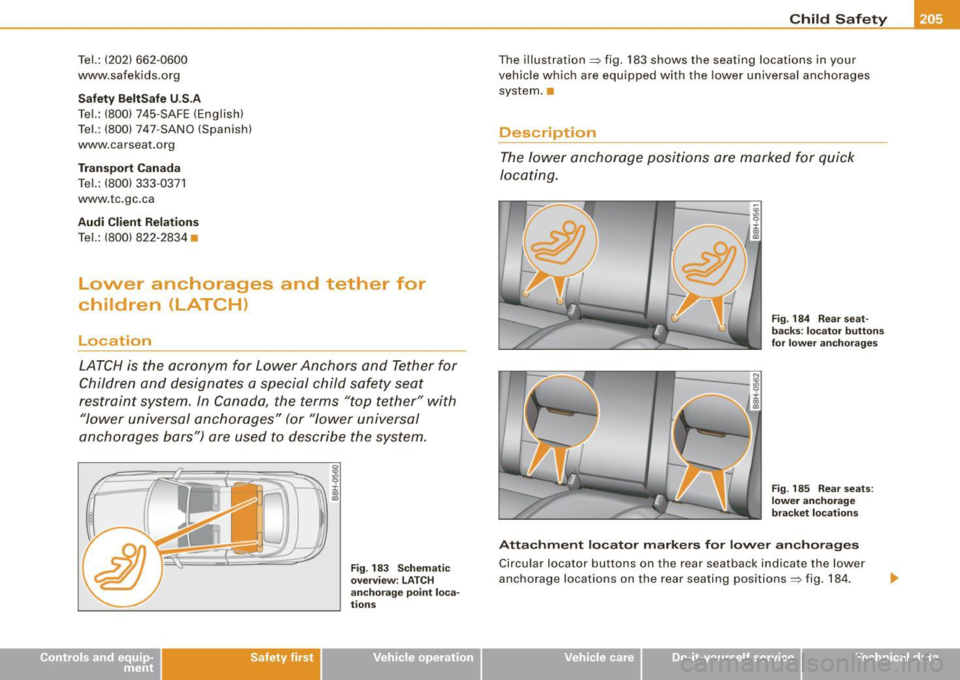
Tel.: (202) 662-0600
www.safekids.org
Safety BeltSafe U .S .A
Tel.: (800) 745-SAFE (English)
Tel.: (800) 747-SANO (Spanish)
www.carseat.org
Transport Canada
Tel.: (800) 333-0371
www.tc .gc.ca
Audi Client Relations
Tel.: (800) 822-2834 •
Lower anchorages and tether for
children (LATCH}
Location
LATCH is the acronym for Lower Anchors and Tether for
Children and designates a special child safety seat
restraint system . In Canada , the terms "top tether" with
"lower universal anchorages" (or "lower universal
anchorages bars") are used to describe the system.
Safety first
I :c 00
"'
Fig. 183 Schematic
overview: LATCH
anchorage point loca
tions
Child Safety
The illustration~ fig. 183 shows the seating locations in your
vehicle which are equipped with the lower universal anchorages system .•
Description
The lower anchorage positions are marked for quick
locating.
Fig. 184 Rear seat
backs : locator buttons
for lower anchorages
Fig . 185 Rear seats:
lower anchorage
bracket locations
Attachment locator markers for lower anchorages
Circular locator buttons on the rear seatback indicate the lower
anchorage locations on the rear seating positions ~ fig. 184.
~ehicle care irechnical data
Page 208 of 340
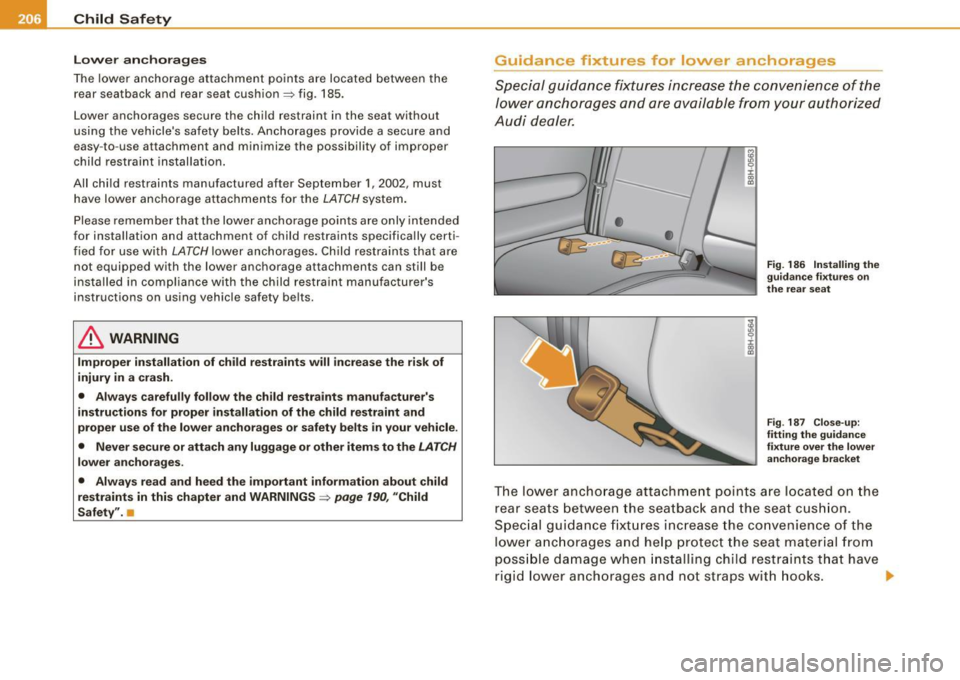
___ C_h_ i_ld _ S_ a_ f_ e_ t-= y'------------------------------------------------
Lower anchorages
The lower anchorage attachment points are located between the
rear seatback and rear seat cushion=> fig. 185.
Lower anchorages secure the child restraint in the seat without
using the vehicle's safety belts. Anchorages provide a secure and
easy -to -use attachment and minimize the possibility of improper
child restraint installation.
All child restraints manufactured after September 1, 2002, must have lower anchorage attachments for the
LATCH system.
Please remember that the lower anchorage points are only intended
for installation and attachment of child restraints specifically certi
fied for use with
LATCH lower anchorages. Child restraints that are
not equipped with the lower anchorage attachments can still be
installed in compliance with the child restraint manufacturer's
instructions on using vehicle safety belts.
& WARNING
Improper installation of child restraints will increase the risk of
injury in a crash.
• Always carefully follow the child restraints manufacturer's
instructions for proper installation of the child restraint and
proper use of the lower anchorages or safety belts in your vehicle.
• Never secure or attach any luggage or other items to the LATCH
lower anchorages.
• Always read and heed the important information about child
restraints in this chapter and
WARNINGS :::> page 190, "Child
Safety".•
Guidance fixtures for lower anchorages
Special guidance fixtures increase the convenience of the
lower anchorages and are available from your authorized
Audi dealer.
!6
"' 0 ± .,
"'
Fig. 186 Installing the
guidance fixtures on
the rear seat
Fig . 187 Close-up:
fitting the guidance
fixture over the lower
anchorage bracket
The lower anchorage attachment points are located on the
rear seats between the seatback and the seat cushion.
Special guidance fixtures increase the convenience of the
lower anchorages and help protect the seat material from
possible damage when installing child restraints that have
rigid lower anchorages and not straps with hooks. .,
Page 209 of 340
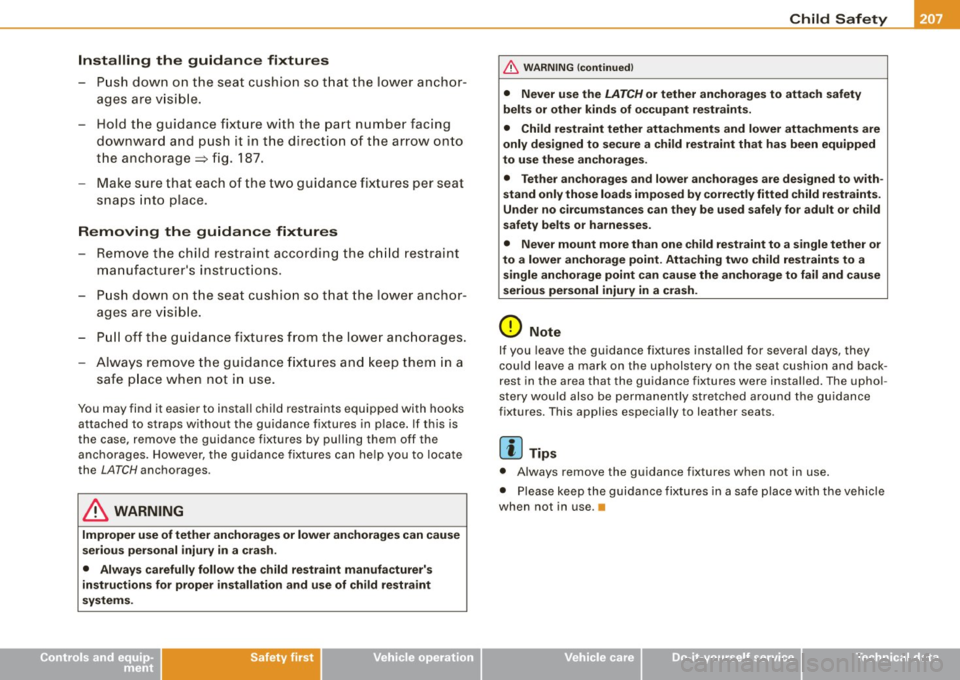
_______________________________________________ C_h _i_ld _ S_ a_ f_ e_ t...: Y _ _____.1!1111
Installing the guidance fixtures
- Push down on the seat cushion so that the lower anchor
ages are visible.
- Hold the guidance fixture with the part number facing downward and push it in the direction of the arrow onto
the anchorage :::::, fig. 187.
- Make sure that each of the two guidance fixtures per seat
snaps into place.
Removing the guidance fixtures
- Remove the child restraint according the child restraint
manufacturer's instructions.
- Push down on the seat cushion so that the lower anchor
ages are visible.
- Pull off the guidance fixtures from the lower anchorages.
- Always remove the guidance fixtures and keep them in a
safe place when not in use.
You may find it easier to install child restraints equipped with hooks
attached to straps without the guidance fixtures in place. If this is
the case, remove the guidance fixtures by pulling them off the
anchorages . However, the guidance fixtures can help you to locate
the
LATCH anchorages.
& WARNING
Improper use of tether anchorages or lower anchorages can cause
serious personal injury in a crash.
• Always carefully follow the child restraint manufacturer's
instructions for proper installation and use of child restraint
systems.
Controls and equip ment Safety first Vehicle operation
& WARNING (continued)
•
Never use the LATCH or tether anchorages to attach safety
belts or other kinds of occupant restraints.
• Child restraint tether attachments and lower attachments are
only designed to secure a child restraint that has been equipped
to use these anchorages.
• Tether anchorages and lower anchorages are designed to with
stand only those loads imposed by correctly fitted child restraints.
Under no circumstances can they be used safely for adult or child
safety belts or harnesses.
• Never mount more than one child restraint to a single tether or
to a lower anchorage point. Attaching two child restraints to a
single anchorage point can cause the anchorage to fail and cause
serious personal injury in a crash.
0 Note
If you leave the guidance fixtures installed for several days, they
could leave a mark on the upholstery on the seat cushion and back
rest in the area that the guidance fixtures were installed. The uphol
stery would also be permanently stretched around the guidance
fixtures. This applies especially to leather seats.
[ i] Tips
• Always remove the guidance fixtures when not in use.
• Please keep the guidance fixtures in a safe place with the vehicle
when not in use .•
Vehicle care Do-it-yourself service Technical data
Page 210 of 340
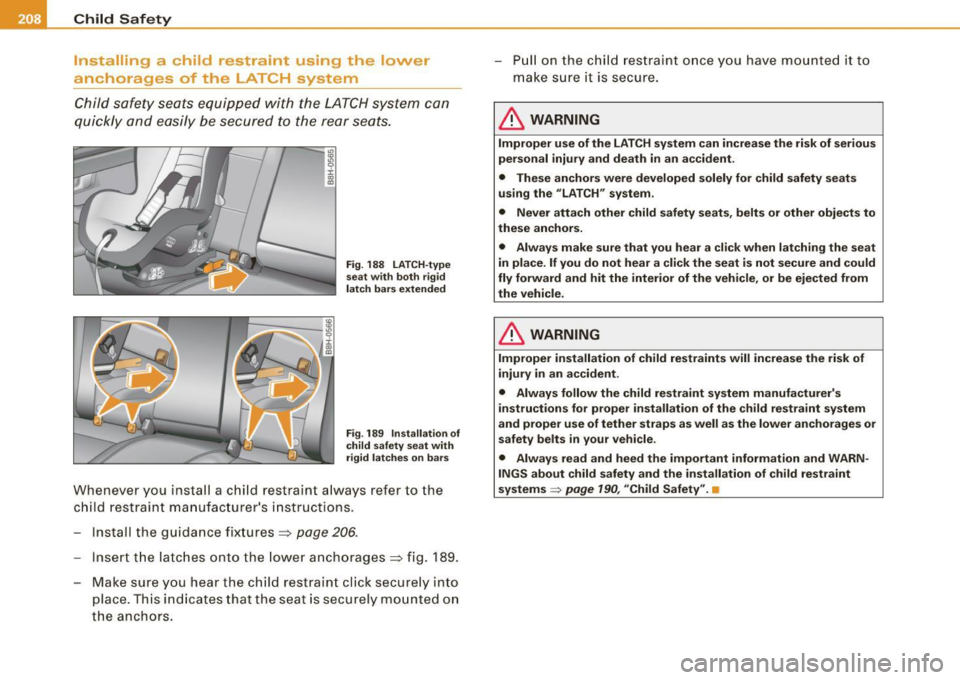
___ C_h_ i_ld _ S_ a_ f_ e_ t-= y'------------------------------------------------
Install ing a child restraint using the lower
anchorages of the LA TC H system
Child safety seats equipped with the LATCH system can
quickly and easily be secured to the rear seats.
Fig. 188 LATCH-type
seat with both rigid
latch bars extended
Fig. 189 Installation of
child safety seat with
rigid latches on bars
Whenever you install a child restraint always refer to the
child restraint manufacturer's instructions.
- Install the guidance fixtures=:>
page 206.
-Insert the latches onto the lower anchorages=:, fig. 189.
Make sure you hear the child restraint click securely into
place. This indicates that the seat is securely mounted on
the anchors. -
Pull on the child restraint once you have mounted it to
make sure it is secure.
& WARNING
Improper use of the LATCH system can increase the risk of serious
personal injury and death in an accident.
• These anchors were developed solely for child safety seats
using the "LATCH" system.
• Never attach other child safety seats, belts or other objects to
these anchors.
• Always make sure that you hear a click when latching the seat
in place. If you do not hear a click the seat is not secure and could
fly forward and hit the interior of the vehicle, or be ejected from
the vehicle.
& WARNING
Improper installation of child restraints will increase the risk of
injury in an accident .
• Always follow the child restraint system manufacturer's
instructions for proper installation of the child restraint system
and proper use of tether straps as well as the lower anchorages or
safety belts in your vehicle.
• Always read and heed the important information and WARN
INGS about child safety and the installation of child restraint
systems ~
page 190, "Child Safety". •